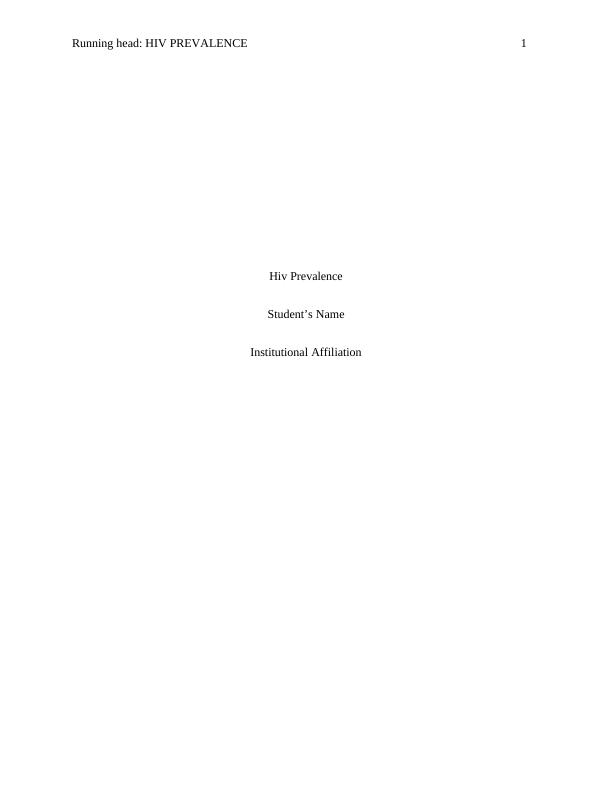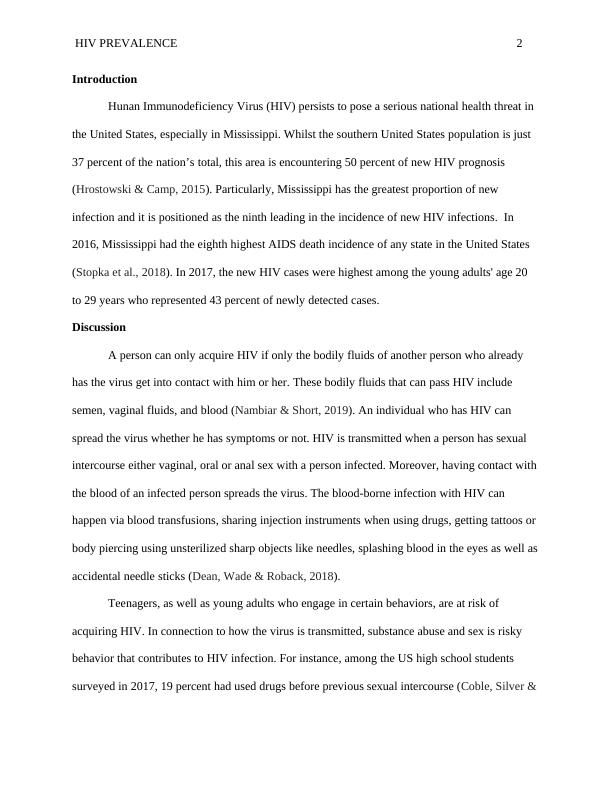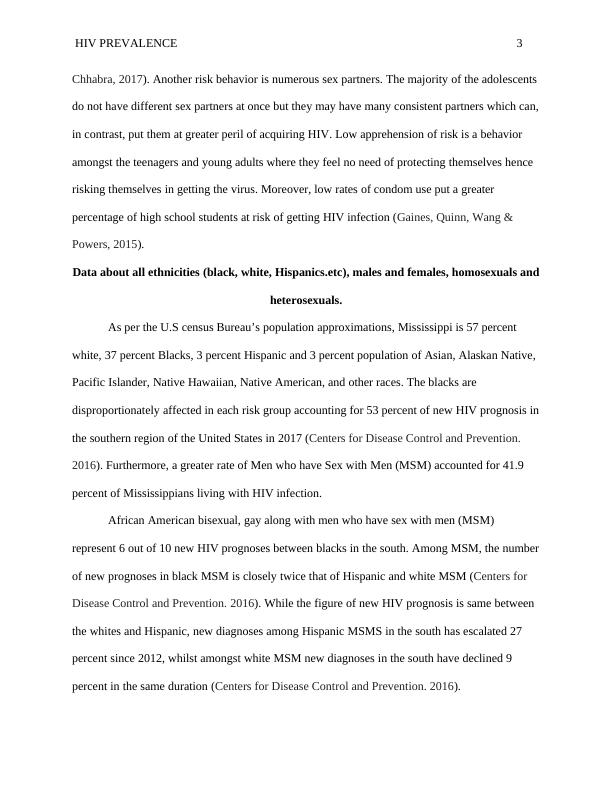HIV Prevalence in Mississippi: A Serious Health Threat
Added on 2023-01-20
10 Pages2654 Words71 Views
Running head: HIV PREVALENCE 1
Hiv Prevalence
Student’s Name
Institutional Affiliation
Hiv Prevalence
Student’s Name
Institutional Affiliation

HIV PREVALENCE 2
Introduction
Hunan Immunodeficiency Virus (HIV) persists to pose a serious national health threat in
the United States, especially in Mississippi. Whilst the southern United States population is just
37 percent of the nation’s total, this area is encountering 50 percent of new HIV prognosis
(Hrostowski & Camp, 2015). Particularly, Mississippi has the greatest proportion of new
infection and it is positioned as the ninth leading in the incidence of new HIV infections. In
2016, Mississippi had the eighth highest AIDS death incidence of any state in the United States
(Stopka et al., 2018). In 2017, the new HIV cases were highest among the young adults' age 20
to 29 years who represented 43 percent of newly detected cases.
Discussion
A person can only acquire HIV if only the bodily fluids of another person who already
has the virus get into contact with him or her. These bodily fluids that can pass HIV include
semen, vaginal fluids, and blood (Nambiar & Short, 2019). An individual who has HIV can
spread the virus whether he has symptoms or not. HIV is transmitted when a person has sexual
intercourse either vaginal, oral or anal sex with a person infected. Moreover, having contact with
the blood of an infected person spreads the virus. The blood-borne infection with HIV can
happen via blood transfusions, sharing injection instruments when using drugs, getting tattoos or
body piercing using unsterilized sharp objects like needles, splashing blood in the eyes as well as
accidental needle sticks (Dean, Wade & Roback, 2018).
Teenagers, as well as young adults who engage in certain behaviors, are at risk of
acquiring HIV. In connection to how the virus is transmitted, substance abuse and sex is risky
behavior that contributes to HIV infection. For instance, among the US high school students
surveyed in 2017, 19 percent had used drugs before previous sexual intercourse (Coble, Silver &
Introduction
Hunan Immunodeficiency Virus (HIV) persists to pose a serious national health threat in
the United States, especially in Mississippi. Whilst the southern United States population is just
37 percent of the nation’s total, this area is encountering 50 percent of new HIV prognosis
(Hrostowski & Camp, 2015). Particularly, Mississippi has the greatest proportion of new
infection and it is positioned as the ninth leading in the incidence of new HIV infections. In
2016, Mississippi had the eighth highest AIDS death incidence of any state in the United States
(Stopka et al., 2018). In 2017, the new HIV cases were highest among the young adults' age 20
to 29 years who represented 43 percent of newly detected cases.
Discussion
A person can only acquire HIV if only the bodily fluids of another person who already
has the virus get into contact with him or her. These bodily fluids that can pass HIV include
semen, vaginal fluids, and blood (Nambiar & Short, 2019). An individual who has HIV can
spread the virus whether he has symptoms or not. HIV is transmitted when a person has sexual
intercourse either vaginal, oral or anal sex with a person infected. Moreover, having contact with
the blood of an infected person spreads the virus. The blood-borne infection with HIV can
happen via blood transfusions, sharing injection instruments when using drugs, getting tattoos or
body piercing using unsterilized sharp objects like needles, splashing blood in the eyes as well as
accidental needle sticks (Dean, Wade & Roback, 2018).
Teenagers, as well as young adults who engage in certain behaviors, are at risk of
acquiring HIV. In connection to how the virus is transmitted, substance abuse and sex is risky
behavior that contributes to HIV infection. For instance, among the US high school students
surveyed in 2017, 19 percent had used drugs before previous sexual intercourse (Coble, Silver &

HIV PREVALENCE 3
Chhabra, 2017). Another risk behavior is numerous sex partners. The majority of the adolescents
do not have different sex partners at once but they may have many consistent partners which can,
in contrast, put them at greater peril of acquiring HIV. Low apprehension of risk is a behavior
amongst the teenagers and young adults where they feel no need of protecting themselves hence
risking themselves in getting the virus. Moreover, low rates of condom use put a greater
percentage of high school students at risk of getting HIV infection (Gaines, Quinn, Wang &
Powers, 2015).
Data about all ethnicities (black, white, Hispanics.etc), males and females, homosexuals and
heterosexuals.
As per the U.S census Bureau’s population approximations, Mississippi is 57 percent
white, 37 percent Blacks, 3 percent Hispanic and 3 percent population of Asian, Alaskan Native,
Pacific Islander, Native Hawaiian, Native American, and other races. The blacks are
disproportionately affected in each risk group accounting for 53 percent of new HIV prognosis in
the southern region of the United States in 2017 (Centers for Disease Control and Prevention.
2016). Furthermore, a greater rate of Men who have Sex with Men (MSM) accounted for 41.9
percent of Mississippians living with HIV infection.
African American bisexual, gay along with men who have sex with men (MSM)
represent 6 out of 10 new HIV prognoses between blacks in the south. Among MSM, the number
of new prognoses in black MSM is closely twice that of Hispanic and white MSM (Centers for
Disease Control and Prevention. 2016). While the figure of new HIV prognosis is same between
the whites and Hispanic, new diagnoses among Hispanic MSMS in the south has escalated 27
percent since 2012, whilst amongst white MSM new diagnoses in the south have declined 9
percent in the same duration (Centers for Disease Control and Prevention. 2016).
Chhabra, 2017). Another risk behavior is numerous sex partners. The majority of the adolescents
do not have different sex partners at once but they may have many consistent partners which can,
in contrast, put them at greater peril of acquiring HIV. Low apprehension of risk is a behavior
amongst the teenagers and young adults where they feel no need of protecting themselves hence
risking themselves in getting the virus. Moreover, low rates of condom use put a greater
percentage of high school students at risk of getting HIV infection (Gaines, Quinn, Wang &
Powers, 2015).
Data about all ethnicities (black, white, Hispanics.etc), males and females, homosexuals and
heterosexuals.
As per the U.S census Bureau’s population approximations, Mississippi is 57 percent
white, 37 percent Blacks, 3 percent Hispanic and 3 percent population of Asian, Alaskan Native,
Pacific Islander, Native Hawaiian, Native American, and other races. The blacks are
disproportionately affected in each risk group accounting for 53 percent of new HIV prognosis in
the southern region of the United States in 2017 (Centers for Disease Control and Prevention.
2016). Furthermore, a greater rate of Men who have Sex with Men (MSM) accounted for 41.9
percent of Mississippians living with HIV infection.
African American bisexual, gay along with men who have sex with men (MSM)
represent 6 out of 10 new HIV prognoses between blacks in the south. Among MSM, the number
of new prognoses in black MSM is closely twice that of Hispanic and white MSM (Centers for
Disease Control and Prevention. 2016). While the figure of new HIV prognosis is same between
the whites and Hispanic, new diagnoses among Hispanic MSMS in the south has escalated 27
percent since 2012, whilst amongst white MSM new diagnoses in the south have declined 9
percent in the same duration (Centers for Disease Control and Prevention. 2016).

End of preview
Want to access all the pages? Upload your documents or become a member.
Related Documents
Community Health And Population Assignmentlg...
|9
|1988
|12
Analysis of Community Outbreak of HIV/AIDSlg...
|5
|802
|466
Health and Social Characteristics of People with STIslg...
|10
|2599
|307
HIV/AIDS in MSM Relationships: Health Risks, Barriers to Implementation, and Recommended Strategieslg...
|1
|565
|67
